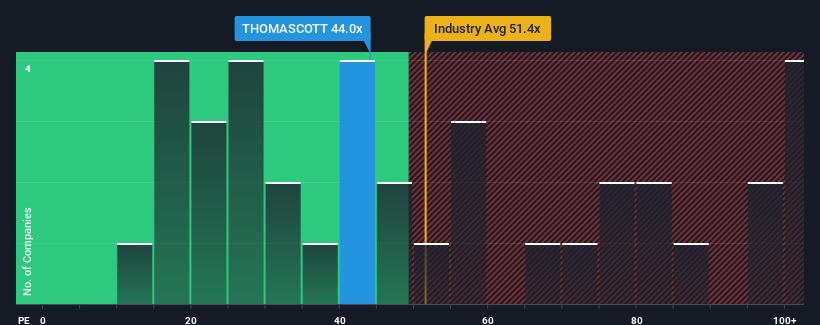- India
- /
- Specialty Stores
- /
- NSEI:THOMASCOTT
Thomas Scott (India) Limited's (NSE:THOMASCOTT) 27% Share Price Surge Not Quite Adding Up
Despite an already strong run, Thomas Scott (India) Limited (NSE:THOMASCOTT) shares have been powering on, with a gain of 27% in the last thirty days. This latest share price bounce rounds out a remarkable 514% gain over the last twelve months.
Since its price has surged higher, given around half the companies in India have price-to-earnings ratios (or "P/E's") below 31x, you may consider Thomas Scott (India) as a stock to potentially avoid with its 44x P/E ratio. Although, it's not wise to just take the P/E at face value as there may be an explanation why it's as high as it is.
Recent times have been quite advantageous for Thomas Scott (India) as its earnings have been rising very briskly. The P/E is probably high because investors think this strong earnings growth will be enough to outperform the broader market in the near future. If not, then existing shareholders might be a little nervous about the viability of the share price.
See our latest analysis for Thomas Scott (India)

Does Growth Match The High P/E?
There's an inherent assumption that a company should outperform the market for P/E ratios like Thomas Scott (India)'s to be considered reasonable.
Retrospectively, the last year delivered an exceptional 173% gain to the company's bottom line. Although, its longer-term performance hasn't been as strong with three-year EPS growth being relatively non-existent overall. Therefore, it's fair to say that earnings growth has been inconsistent recently for the company.
Weighing that recent medium-term earnings trajectory against the broader market's one-year forecast for expansion of 25% shows it's noticeably less attractive on an annualised basis.
With this information, we find it concerning that Thomas Scott (India) is trading at a P/E higher than the market. Apparently many investors in the company are way more bullish than recent times would indicate and aren't willing to let go of their stock at any price. Only the boldest would assume these prices are sustainable as a continuation of recent earnings trends is likely to weigh heavily on the share price eventually.
What We Can Learn From Thomas Scott (India)'s P/E?
Thomas Scott (India)'s P/E is getting right up there since its shares have risen strongly. It's argued the price-to-earnings ratio is an inferior measure of value within certain industries, but it can be a powerful business sentiment indicator.
We've established that Thomas Scott (India) currently trades on a much higher than expected P/E since its recent three-year growth is lower than the wider market forecast. Right now we are increasingly uncomfortable with the high P/E as this earnings performance isn't likely to support such positive sentiment for long. Unless the recent medium-term conditions improve markedly, it's very challenging to accept these prices as being reasonable.
Before you settle on your opinion, we've discovered 3 warning signs for Thomas Scott (India) (2 are concerning!) that you should be aware of.
It's important to make sure you look for a great company, not just the first idea you come across. So take a peek at this free list of interesting companies with strong recent earnings growth (and a low P/E).
Valuation is complex, but we're here to simplify it.
Discover if Thomas Scott (India) might be undervalued or overvalued with our detailed analysis, featuring fair value estimates, potential risks, dividends, insider trades, and its financial condition.
Access Free AnalysisHave feedback on this article? Concerned about the content? Get in touch with us directly. Alternatively, email editorial-team (at) simplywallst.com.
This article by Simply Wall St is general in nature. We provide commentary based on historical data and analyst forecasts only using an unbiased methodology and our articles are not intended to be financial advice. It does not constitute a recommendation to buy or sell any stock, and does not take account of your objectives, or your financial situation. We aim to bring you long-term focused analysis driven by fundamental data. Note that our analysis may not factor in the latest price-sensitive company announcements or qualitative material. Simply Wall St has no position in any stocks mentioned.
About NSEI:THOMASCOTT
Thomas Scott (India)
Manufactures and trades in textile and textile related products in India.
Excellent balance sheet with acceptable track record.
Similar Companies
Market Insights
Community Narratives



